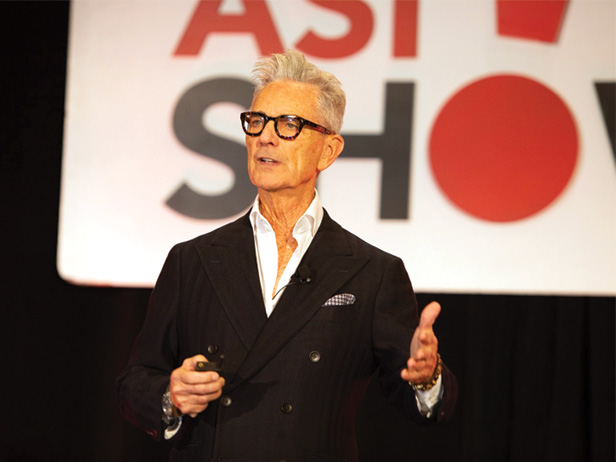March 07, 2024
ASI Fort Worth 2024: Bruce Himelstein Reveals the Keys To Transforming Brand Identity
The keynote on the final day of the show examined how to succeed in the face of disruption.
“Disruption” is everywhere, according to Bruce Himelstein, a marketing expert with over 30 years of experience building luxury hospitality brands.
The keynote speaker for the third day of the ASI Show Fort Worth and an inductee in the American Marketing Hall of Fame, Himelstein used the phrase in the typical sense, referring to major events with the capacity to cause serious change in industries. But in a talk filled with examples of successful branding from his storied career and in the business world, he noted that the phrase also denotes innovators who take experimental risks in sales and marketing.
“You have to keep moving,” he said. “If it’s ‘this is how we do it, this is the only way we do it,’ you’ve already lost, because disruption is going to happen. It’s just how your organization gets ready for it.”

Bruce Himelstein drew on his career of working with luxury hotel brands to discuss branding and disruption in his keynote talk at the ASI Show Fort Worth.
Himelstein would know. During his tenure as the chief sales & marketing officer for The Ritz-Carlton Hotel Company, major disruption happened during the crash of ‘08 and the advent of Airbnb, a company “with disruption on its mind,” according to Himelstein.
“Not once did anyone mention someone’s spare bedroom would become a competitor,” he said.
Himelstein dealt with those shifting forces directly when, in 2002, he was charged with completely re-examining The Ritz Carlton’s brand identity and perception.
Himelstein realized that people were intimidated by the luxury hotel chain; that the pristine white tablecloths and perception of it being a place for “one’s aunt to take them for tea on their birthday” was not serving in its best interest, and that the luxury market’s demographic had shifted entirely. Using extensive data to make his case, he spent six months of internal selling to finally align the company on the idea that their marketing efforts needed to appeal to lifestyle, not “bigger ballrooms, silver being polished better, or cooler wine.”
“Data is your best salesperson,” he said. “Once I shared the data, it was game over. You may not like the data, but you can’t argue with it, so use it.”
Demographics will shift and businesses need to tap into new segments, but it’s not about making dramatic, overhauling measures. When appealing to the newer generation, for instance, Himelstein said, “you can’t be a light switch, because you lose half your clientele. It’s subliminal. You must be careful that it’s staged, so you don’t lose loyalty.”
ASI Show Fort Worth keynote speaker Bruce Himelstein joined ASI Media Data Analytics Editor Sami Marshak to discuss his career in the hospitality industry and why using data is so powerful.
Himelstein also examined incrementality and ways to increase profit through strategic and truly unique initiatives. He mentioned Karl Lagerfeld, the designer for Chanel, partnering with H&M for a T-shirt line and fashion designer Vera Wang’s collection with Kohl’s – a “strange bedfellows” approach that increased their brand relevance by tapping into new consumer segments and garnered high-profile attention.
Himelstein encouraged the audience to think outside of the box for partnerships and to get creative. It can look different to everyone, but he states it’s about thinking what services and offerings brands can charge more for. “Customers will pay a premium for service,” he said. “It’s about taking a customer and never giving them a reason to go to another company.”
In a Q&A with ASI President & CEO Tim Andrews after the conclusion of his talk, Himelstein further explained by using the example of a manager of a hotel company overhearing that a man couldn’t access the beach due to his wheelchair. The manager contacted the director of engineering, who drove to a hardware store and created a makeshift ramp for the customer. It cost maybe $200 in supplies and an hour or two in time, but the end result he said was a customer for life.
It’s about short term-survival and long-term growth, according to Himelstein. Not every brand will have the marketing dollars aligned with luxury companies like The Ritz Carlton, but it doesn’t take huge budgets to achieve results. Said Himelstein: “Get creative with it, get with your teams, and figure out what this could look like for you.”
